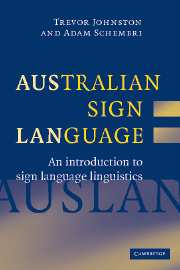Book contents
- Frontmatter
- Contents
- Acknowledgements
- Conventions for sign notation
- 1 Signed languages and linguistics
- 2 Auslan in social context
- 3 Auslan and other signed languages
- 4 Phonetics and phonology: the building blocks of signs
- 5 Morphology: sign formation and modification
- 6 Lexicon: the structure of Auslan vocabulary
- 7 Syntax: the structure of sentences in Auslan
- 8 Semantics and pragmatics: sign meaning and sentence meaning
- 9 Discourse: structure and use above the sentence
- 10 Issues in the study of signed languages
- References
- Index
10 - Issues in the study of signed languages
Published online by Cambridge University Press: 02 December 2009
- Frontmatter
- Contents
- Acknowledgements
- Conventions for sign notation
- 1 Signed languages and linguistics
- 2 Auslan in social context
- 3 Auslan and other signed languages
- 4 Phonetics and phonology: the building blocks of signs
- 5 Morphology: sign formation and modification
- 6 Lexicon: the structure of Auslan vocabulary
- 7 Syntax: the structure of sentences in Auslan
- 8 Semantics and pragmatics: sign meaning and sentence meaning
- 9 Discourse: structure and use above the sentence
- 10 Issues in the study of signed languages
- References
- Index
Summary
Throughout this introduction to the linguistics of Auslan, we have attempted to point out that there are debates regarding the most appropriate analysis of some of the linguistic features we have presented. In many cases, it is not the presence or absence of specific phenomena in signed languages which is in question. For example, most researchers accept the existence of the dominance and symmetry conditions in signed language formational structure (Sutton-Spence & Woll, 1999; Sandler & Lillo-Martin, 2006). Instead, debate surrounds the status these phenomena have in a specific signed language such as Auslan or ASL, in signed languages generally, and even in the everyday use of speech and gesture (van Gijn et al., in press). For example, are there aspects of the dominance and symmetry conditions that are unique to signed languages, or are they similar to what we see in the gesture that accompanies spoken language?
The areas that create the most debate appear to relate strongly to modality differences: signed languages are visual-gestural languages whereas spoken languages are auditory-oral languages (although they may be accompanied by gesture). Does this difference in modality impact on language structure in a fundamental way? For example, is the movement of indicating verbs in space best described as a system of verb agreement entirely comparable to that found in the morphology of verb agreement in spoken languages (e.g., Padden, 1988)? Alternatively, can it be understood as a blend of linguistic and gestural elements (which may or may not differ in degree or kind with the role of gesture in spoken languages) (e.g., Liddell, 2003)?
- Type
- Chapter
- Information
- Australian Sign Language (Auslan)An introduction to sign language linguistics, pp. 279 - 296Publisher: Cambridge University PressPrint publication year: 2007



